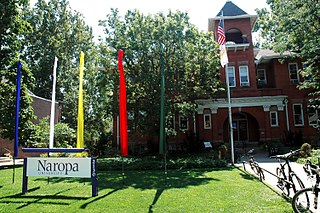Related Research Articles

Chögyam Trungpa was a Tibetan Buddhist meditation master and holder of both the Kagyu and Nyingma lineages of Tibetan Buddhism.

Mahāmudrā literally means "great seal" or "great imprint" and refers to the fact that "all phenomena inevitably are stamped by the fact of wisdom and emptiness inseparable". Mahāmudrā is a multivalent term of great importance in later Indian Buddhism and Tibetan Buddhism which "also occurs occasionally in Hindu and East Asian Buddhist esotericism."
Buddhism in the West broadly encompasses the knowledge and practice of Buddhism outside of Asia in the Western world. Occasional intersections between Western civilization and the Buddhist world have been occurring for thousands of years. The first Westerners to become Buddhists were Greeks who settled in Bactria and India during the Hellenistic period. They became influential figures during the reigns of the Indo-Greek kings, whose patronage of Buddhism led to the emergence of Greco-Buddhism and Greco-Buddhist art. There was little contact between the Western and Buddhist cultures during most of the Middle Ages but the early modern rise of global trade and mercantilism, improved navigation technology and the European colonization of Asian Buddhist countries led to increased knowledge of Buddhism among Westerners. This increased contact led to various responses from Buddhists and Westerners throughout the modern era. These include religious proselytism, religious polemics and debates, Buddhist modernism, Western convert Buddhists and the rise of Buddhist studies in Western academia. During the 20th century, there was a growth in Western Buddhism due to various factors such as immigration, globalization, the decline of Christianity and increased interest among Westerners. The various schools of Buddhism are now established in all major Western countries making up a small minority in the United States, Europe, Australia and New Zealand.

Naropa University is a private university in Boulder, Colorado. Founded in 1974 by Tibetan Buddhist teacher Chögyam Trungpa, it is named after the 11th-century Indian Buddhist sage Naropa, an abbot of Nalanda. The university describes itself as Buddhist-inspired, ecumenical, and nonsectarian rather than Buddhist. Naropa promotes non-traditional activities like meditation to supplement traditional learning approaches.

Thrangu Rinpoche was born in Kham, Tibet. He was deemed to be a prominent tulku in the Kagyu school of Tibetan Buddhism, the ninth reincarnation in his particular line. His full name and title was the Very Venerable Ninth Khenchen Thrangu Tulku, Karma Lodrö Lungrik Maway Senge. The academic title Khenchen denotes great scholarly accomplishment, and the term Rinpoche is a Tibetan devotional title which may be accorded to respected teachers and exemplars.

Gampo Abbey is a Western Buddhist monastery in the Shambhala tradition in Nova Scotia, Canada on the edge of the Pleasant Bay community. Founded by Chögyam Trungpa Rinpoche in 1983, it is a lineage institution of Shambhala and a corporate division of the Vajradhatu Buddhist Church of Canada.

Vajradhatu was the name of the umbrella organization of Chögyam Trungpa Rinpoche, one of the first Tibetan Buddhist lamas to visit and teach in the West. It served as the vehicle for the promulgation of his teachings, and was also the name by which his community was known from 1973 until 1990. Starting in 1976 it was paralleled by a governmental structure for establishing the non-denominational enlightened society of Shambhala Kingdom, which included Shambhala Training among many other activities. In February 2000, the Vajradhatu organization was renamed Shambhala International by Sakyong Mipham Rinpoche.

Karmê Chöling is a Shambhala Buddhist meditation retreat center and community in Barnet, Vermont. It was originally known as "Tail of the Tiger". The staff there offers meditation programs and retreats in the Shambhala Buddhist tradition to hundreds of students each year. Karmê Chöling facilities include 717 acres of wooded land, seven meditation halls, a Zen archery range, an organic garden, dining facilities, single and double rooms, dormitory housing, and seven retreat cabins. The center also houses visitors and staff in tents on wooden platforms in the warmer months of May through September. The center gives retreats, seminars, and workshops on meditation, gardening, archery, and theater.

Sakyong Jamgon Mipham Rinpoche, Jampal Trinley Dradül is a Tibetan Buddhist lama and holder of the Sakyong Lineage of Mukpodong, a family lineage. The Sakyong was recognized in 1995 as the tulku (reincarnation) of Mipham the Great, the great Rime teacher of the late 19th century.

Shambhala International is the umbrella organization that encompasses many of the distinct institutions of the Shambhala spiritual community, founded by the students of the Tibetan Buddhist teacher Chögyam Trungpa Rinpoche.
Judith Simmer-Brown is a Distinguished Professor of Contemplative and Religious Studies Emerita at Naropa University. She has expertise in Tibetan Buddhism, Women and Buddhism, Buddhist-Christian dialogue, Western Buddhism and Contemplative Education. She is an acharya — a senior Buddhist teacher — in the Shambhala Buddhist tradition and was a senior student of Chögyam Trungpa Rinpoche. She serves on the board of the Society of Buddhist-Christian Studies, and is on the steering committee of the Contemplative Studies Group of the American Academy of Religion. Previously she was a member of the Lilly Buddhist-Christian Theological Encounter.
Tonglen is Tibetan for 'giving and taking', and refers to a meditation practice found in Tibetan Buddhism.
Joseph Goldstein is one of the first American vipassana teachers, co-founder of the Insight Meditation Society (IMS) with Jack Kornfield and Sharon Salzberg, a contemporary author of numerous popular books on Buddhism, a resident guiding teacher at IMS, and a leader of retreats worldwide on insight (vipassana) and lovingkindness (metta) meditation.

In Tibetan Buddhism, the Three Jewels and Three Roots are supports in which a Buddhist takes refuge by means of a prayer or recitation at the beginning of the day or of a practice session. The Three Jewels are the first and the Three Roots are the second set of three Tibetan Buddhist refuge formulations, the Outer, Inner and Secret forms of the Three Jewels. The 'Outer' form is the 'Triple Gem', the 'Inner' is the Three Roots and the 'Secret' form is the 'Three Bodies' or trikāya of a Buddha.

Shambhala Training is a secular approach to meditation and a new religious movement developed by Tibetan Buddhist teacher Chögyam Trungpa Rinpoche and his students. It is based on what Trungpa calls Shambhala Vision, which sees enlightened society as not purely mythical, but as realizable by people of all faiths through practices of mindfulness/awareness, non-aggression, and sacred outlook.
Contemplative psychotherapy is an approach to psychotherapy that includes the use of personal contemplative practices and insights informed by the spiritual tradition of Buddhism. Contemplative psychotherapy differs from other, more traditional methods of counseling in that the therapist brings to the therapeutic relationship qualities of mindfulness and compassion in order to help clients access their fundamental goodness and natural wisdom. The practice of Contemplative Psychotherapy grew out of a dialogue between Tibetan Buddhist master Chogyam Trungpa Rinpoche and Western psychologists and psychiatrists. This discussion led to the opening of the Contemplative Psychotherapy Department at Naropa University in 1978 by Edward M. Podvoll, a psychiatrist, psychoanalyst and dedicated student of Trungpa.

Shenlha Ökar or Shiwa Ökar is the most important deity in the Yungdrung Bon tradition of Tibet. He is counted among the "Four Transcendent Lords" along with Satrig Ersang, Sangpo Bumtri, and Tonpa Shenrab Miwoche.
The term spiritual warrior is used in Tibetan Buddhism for one who combats the universal enemy: self-ignorance (avidya), the ultimate source of suffering according to Buddhist philosophy. Different from other paths, which focus on individual salvation, the spiritual warrior's only complete and right practice is that which compassionately helps other beings with wisdom. This is the Bodhisattva ideal, the spiritual warrior who resolves to attain buddhahood in order to liberate others. The term is also used generically in esotericism and self-help literature. Spiritual warrior, "illuminated heart and valiant one", "enlightenment hero", "one who aspires for enlightenment" or, "heroic being" has been defined as a bodhisattva.
Susan Kathryn Hookham, known as LamaShenpen Hookham is a Buddhist teacher who has trained for over 50 years in the Mahamudra and Dzogchen traditions of Tibetan Buddhism.
In the Nyingma Tibetan Buddhist Dharma teachings faith's essence is to make one's being, and perfect dharma, inseparable. The etymology is the aspiration to achieve one's goal. Faith's virtues are like a fertile field, a wishing gem, a king who enforces the law, someone who holds the carefulness stronghold, a boat on a great river and an escort in a dangerous place. Faith in karma causes temporary happiness in the higher realms. Faith is a mental state in the Abhidharma literature's fifty-one mental states. Perfect faith in the Buddha, his Teaching (Dharma) and the Order of his Disciples (Sangha) is comprehending these three jewels of refuge with serene joy based on conviction. The Tibetan word for faith is day-pa, which might be closer in meaning to confidence, or trust.
References
- ↑ Joiner, Whitney (20 February 2008). "Dive-bar dharma". Salon.com . Retrieved 3 December 2014.
- ↑ Prebish, Charles. Luminous Passage: The Practice and Study of Buddhism in America. University of California Press, 1999, p. 170.
- ↑ "Reginald A. Ray @ Dharma Ocean". www.dharmaocean.org. Archived from the original on 2014-07-09.
- ↑ Prebish, C.S. (1999). Luminous Passage: The Practice and Study of Buddhism in America. University of California Press. p. 170. ISBN 978-0-520-92225-9 . Retrieved 2020-12-14.
- 1 2 "Reginald Ray". Naropa University. Retrieved 2020-12-14.
- ↑ "Members". Nālandā Translation Committee. 2016-10-25. Retrieved 2020-12-14.
- ↑ "Chogyam Trungpa: The Early Years". Shambhala Times Community News Magazine. 2014-09-08. Retrieved 2020-12-14.
- ↑ Radner, Rebecca (Spring 2001). "Review: 'Indestructible Truth' by Reginald A. Ray". Tricycle: The Buddhist Review . Retrieved 3 December 2014.
- ↑ Hamilton, Erica Shane (Summer 2011). "The Gifts of Illness: A Buddhist Perspective". Biofeedback. 39 (2): 71–73. doi:10.5298/1081-5937-39.2.05. ProQuest 893884557.